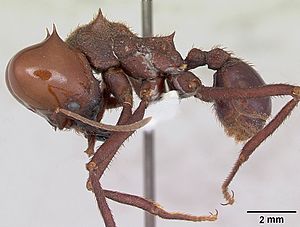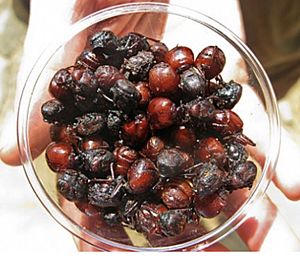Atta laevigata facts for kids
Quick facts for kids Atta laevigata |
|
|---|---|
 |
|
| A. laevigata worker | |
| Scientific classification |
Atta laevigata is a type of leafcutter ant. It was first described by Smith in 1858. These ants are found in South America, from Venezuela down to Paraguay.
This species is one of the largest leafcutter ants. You can recognize it by the smooth, shiny head of its biggest workers. Atta laevigata has many local names. In northern South America, it's called hormiga culona. In Peru, it's sikisapa. In Central America, it's zompopo de mayo. In Venezuela, it's bachaco culón. In Paraguay, it's akango, and in Mexico, chicatana.
A colony of these ants can have about 3.5 million individual ants.
Ants as Food
The hormiga culona has been eaten for hundreds of years. This tradition comes from ancient cultures like the Guanes. People collect these ants for about nine weeks each year. This happens during the rainy season, when the ants take their nuptial flight. A. laevigata ants are even given as traditional gifts at weddings.
Local people collect the ants. The ants have strong jaws, so collectors must be careful. Only the queen ants are collected, as other ants are not eaten. The legs and wings are removed. Then, the ants are soaked in salty water. After that, they are roasted in ceramic pans.
The main places where these ants are prepared are San Gil and Barichara. From there, the ants are sold in cities like Bucaramanga and Bogotá. You can often see packages of ants during the season. Some of these ants are even sent to other countries. They are mainly exported to Canada, England, and Japan.
Scientists at the Industrial University of Santander have studied these ants. They found that the ants are very nutritious. They have a high level of protein. They also have very low levels of saturated fat. This means they are a healthy food source.
The number of Atta laevigata ants is decreasing. Studies show that their population is much smaller than it was twelve years ago. Because of this, people are worried about their future. It is important to protect these ants.
See also
 In Spanish: Hormiga culona para niños
In Spanish: Hormiga culona para niños


